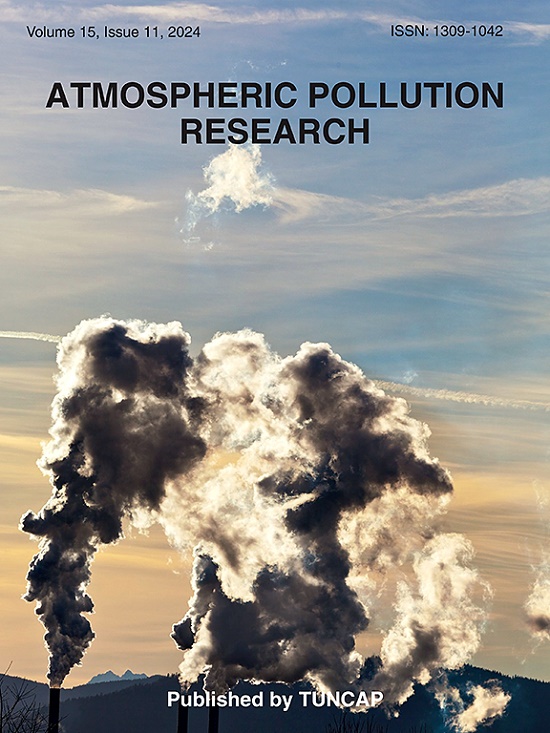Detection of elevated CO₂ and CH₄ emissions from power plant and landfill sites using airborne and spaceborne imaging spectroscopy
IF 3.5
3区 环境科学与生态学
Q2 ENVIRONMENTAL SCIENCES
引用次数: 0
Abstract
Accurate quantification of atmospheric carbon dioxide (CO2) and methane (CH4) emissions from point sources is crucial in advancing our understanding of atmospheric composition and mitigating climate change. In this study, we have established an advanced remote sensing framework using imaging spectrometer data to detect and estimate anomalous concentrations of CO2 and CH4 in the atmosphere from targeted point sources, employing the spectral normalized matched filter (SNMF) algorithm. This algorithm utilizes the distinct absorption features of CO2 and CH4 in the shortwave infrared (SWIR) bands, enabling precise discrimination of emission sources from the atmospheric background. The practical benefits of SNMF are robust detection, background suppression, and better adaptiveness. The SNMF algorithm was rigorously tested at two key sites in tropical atmospheric conditions: Kota Super Thermal Power Station (KSTPS) in Rajasthan, India, for CO2 emission detection and Pirana landfill site in Ahmedabad, India, for CH4 emission detection. Multiple cloud-free satellite observations from PRISMA and EMIT have been used here, and airborne AVIRIS-NG data were also included in the study. The analysis revealed the robustness of the SNMF algorithm for CO2 and CH4 detection in different seasons at the same site, and a comparison was also made between PRISMA and EMIT retrievals. We estimated annual CO2 emissions from KSTPS of 6.35 ± 0.65 megatons and CH4 emissions from the Pirana landfill of 0.80 ± 0.14 megatons. Wind data have been incorporated for uncertainty analysis to enhance the robustness of the emission estimation, and external emission data has been analyzed for validation.
利用机载和星载成像光谱检测发电厂和垃圾填埋场CO₂和CH₄排放升高
准确量化大气点源的二氧化碳(CO2)和甲烷(CH4)排放对于提高我们对大气成分的认识和减缓气候变化至关重要。在这项研究中,我们建立了一个先进的遥感框架,利用成像光谱仪数据,采用光谱归一化匹配滤波(SNMF)算法,从目标点源检测和估计大气中CO2和CH4的异常浓度。该算法利用CO2和CH4在短波红外(SWIR)波段的独特吸收特征,能够从大气背景中精确区分发射源。SNMF的实际优点是鲁棒检测、背景抑制和更好的自适应。SNMF算法在两个热带大气条件下的关键站点进行了严格测试:印度拉贾斯坦邦的Kota超级热电站(KSTPS)用于CO2排放检测,印度艾哈迈达巴德的Pirana垃圾填埋场用于CH4排放检测。这里使用了PRISMA和EMIT的多个无云卫星观测数据,机载的AVIRIS-NG数据也包括在研究中。分析表明SNMF算法对同一地点不同季节CO2和CH4的检测具有鲁棒性,并将PRISMA和EMIT的检索结果进行了比较。我们估计KSTPS的年二氧化碳排放量为6.35±0.65兆吨,皮拉纳垃圾填埋场的CH4排放量为0.80±0.14兆吨。为了提高排放估计的鲁棒性,本文采用了风力数据进行不确定性分析,并对外部排放数据进行了分析验证。
本文章由计算机程序翻译,如有差异,请以英文原文为准。
求助全文
约1分钟内获得全文
求助全文
来源期刊

Atmospheric Pollution Research
ENVIRONMENTAL SCIENCES-
CiteScore
8.30
自引率
6.70%
发文量
256
审稿时长
36 days
期刊介绍:
Atmospheric Pollution Research (APR) is an international journal designed for the publication of articles on air pollution. Papers should present novel experimental results, theory and modeling of air pollution on local, regional, or global scales. Areas covered are research on inorganic, organic, and persistent organic air pollutants, air quality monitoring, air quality management, atmospheric dispersion and transport, air-surface (soil, water, and vegetation) exchange of pollutants, dry and wet deposition, indoor air quality, exposure assessment, health effects, satellite measurements, natural emissions, atmospheric chemistry, greenhouse gases, and effects on climate change.
 求助内容:
求助内容: 应助结果提醒方式:
应助结果提醒方式:


